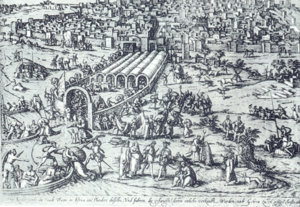| Conquest of Tunis | |||||||||
|---|---|---|---|---|---|---|---|---|---|
| Part of the Ottoman–Habsburg wars and the Ottoman–Portuguese conflicts | |||||||||
 Attack on La Goletta, with Tunis in the background  Entry of Charles V, Holy Roman Emperor, into Tunis in 1535 | |||||||||
| |||||||||
| Belligerents | |||||||||
|
|
| ||||||||
| Commanders and leaders | |||||||||
|
Charles V Andrea Doria Alfonso d'Avalos Álvaro de Bazán García de Toledo Duke of Alba Duke of Beja | Hayreddin Barbarossa | ||||||||
| Strength | |||||||||
|
Total men: 30,000–60,000
Total ships: 398 207 ships[4] 10 galleys 6 galleys 19 galleys Kingdom of Portugal 1 galleon, 2 carracks, 20 round caravels, 8 galleys 8 galleys 1 carrack, 4 galleys 60 hulks |
82 warships[5] 2 galleys[6] | ||||||||
| Casualties and losses | |||||||||
| Unknown: Many fell to dysentery[citation needed] |
30,000 Muslim civilians massacred[7] 9,000 Christians freed | ||||||||
The conquest of Tunis occurred in 1535 when the Habsburg Emperor Charles V and his allies wrestled the city away from the control of the Ottoman Empire.[8]
- ^ Roger Crowley, Empires of the Sea, faber and faber 2008 p. 61
- ^ History of the Ottoman Empire and modern Turkey Ezel Kural Shaw
- ^ José Augusto Amaro Pissarra: O galeão S. João (c. 1530–1551). Dados para uma monografia, Cascais, 1999, p. 195
- ^ 15 galleys of the Mediterranean Squadron, 42 ships of the Cantabrian fleet, 150 ships of the Málaga Squadron
- ^ Crowley, p. 61
- ^ Garnier, p. 96
- ^ A Global Chronology of Conflict: From the Ancient World to the Modern Middle East, Vol. II, ed. Spencer C. Tucker, (ABC-CLIO, 2010), 506.
- ^ Bruce Ware Allen, "Emperor vs. Pirate Tunis, 1535." MHQ: Quarterly Journal of Military History (Winter 2014) 26#2 pp 58–63.